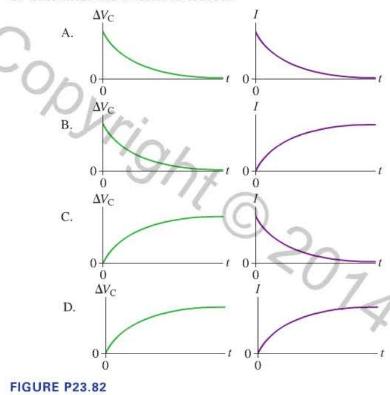Which pair of graphs in Figure P23.82 best represents the capacitor voltage and the current through the
Question:
Which pair of graphs in Figure P23.82 best represents the capacitor voltage and the current through the torso as a function of time after the switch is closed?
A defibrillator is designed to pass a large current through a patient's torso in order to stop dangerous heart rhythms. Its key part is a capacitor that is charged to a high voltage. The patient's torso plays the role of a resistor in an \(R C\) circuit. When a switch is closed, the capacitor discharges through the patient's torso. A jolt from a defibrillator is intended to be intense and rapid; the maximum current is very large, so the capacitor discharges quickly. This rapid pulse depolarizes the heart, stopping all electrical activity. This allows the heart's internal nerve circuitry to reestablish a healthy rhythm.
A typical defibrillator has a \(32 \mu \mathrm{F}\) capacitor charged to \(5000 \mathrm{~V}\). The electrodes connected to the patient are coated with a conducting gel that reduces the resistance of the skin to where the effective resistance of the patient's torso is \(100 \Omega\).
Step by Step Answer:

College Physics A Strategic Approach
ISBN: 9780321907240
3rd Edition
Authors: Randall D. Knight, Brian Jones, Stuart Field





